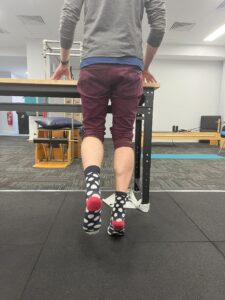So… I sustained my first calf muscle injury the other day. I was out for a slow short run and around the 3km mark started to feel a gradual build up in “tightness” on the outside of my lower right calf. I was able to continue on for the next kilometre, but the sensation started to become a little sharper, at which point I stopped to see if I could alleviate it – I attempted a few stretches, and isometric calf raise holds, which marginally improved things. Only being 2km from home and assuming it was just “tightness”, I was determined to finish. I was able to start again, only for the sensation to become sharp again another kilometre down the road. I was forced to stop again, but this time, walked the remainder of the journey home.
After a cool down, I tested myself out – straight knee calf raise was ok. Bent knee calf raise – a bit sorer. Jump – quite sharp. Hop – unable due to pain.





I had definitely injured my calf! But what part?
The calf complex is made up of three muscles – the gastrocnemius (or gastroc for short), which sits at the top of the calf and originates above the knee; the soleus which sits behind and spans lower than the big gastroc and originates below the knee; and the plantaris which is a very small muscle that originates above the knee (it is rarely injured, and due to evolution may be absent in 12% of people – so we will forget about plantaris for now).
Because of their different attachments, the actions of the two main calf muscles slightly differ – as do their mechanisms of injury. Injury to the gastroc involves a straight knee and a quick powerful movement at the foot and ankle (jumping, landing, sprinting), and is often described as feeling like being shot or kicked in the back of the leg! Injury to the soleus on the other hand tends to be more of an “overuse” or “repetitive strain” injury with the knee in a bent position (ie. longer distance running), and is more described as a gradual build up of tightness/discomfort.
Given my discomfort was lower down in the calf, came on gradually over a few kilometres of slower running, and my discomfort was reproduced on testing more with a bent knee – I deduced I had sustained soleus injury.
Frustrated! for several reasons – I am in the middle of a build for an event later in the year (which will now be a stretch to reach target volume), and there is a bit of a stigma around calf strains being an “older athletes injury”, which is a bit of a reality check for me!
So, why did this happen to me? Some clues may lie in the risk factors for calf muscle injury:
- Calf muscle injuries increase with age
- Check – Although loathed to admit it, I am definitely past my physical prime and fall into this category at 38yo.
- Previous calf muscle injury is one of the biggest predictors
- I don’t tick this one – this is my first calf injury
- Previous lower limb injury in the last 12 months
- I have had several hamstring injuries and a quad injury while playing football, but these were quite a few years ago now, so may potentially be irrelevant, but I did have a flare of knee pain in March this year
- Phase of training – ie. pre-season > mid-season
- Check – I was part way through build for volume for an event in September
- Poorer General health/reduced sleep/elevated stress – levels of increased risk vary between studies, but the link seems to be increasingly well documented. The elevated risk may be due to changes in immune function and inflammation.
- Check – In the previous 2 weeks, I hadn’t run due to moving house (one of the more stressful things in life!), the kids and I had also been unwell, and anyone that has dealt with sick kids can attest – this doesn’t do wonders for your sleep! So, a big tick on all fronts.
There are 3 distinct flags there for me, which definitely paint a picture as part of a clinical history. Could I have prevented it?? A great question! I do strength train twice a week to combat any potential age-related strength decline. And although I did have a small break with illness and other stressful tasks, I did make my first run back particularly short, slow and flat. Could I have lowered the intensity or volume more? Hindsight is a wonderful thing.
Onto my rehab, which I will share in part 2 of this blog.
You can also follow my rehab journey on Instagram by following me @complete.physiodave, or the clinic @complete.physio
References
Dempster, J., Dutheil, F., & Ugbolue, U. C. (2021). The prevalence of lower extremity injuries in running and associated risk factors: a systematic review. Physical Activity and Health, 5(1).
Green, B., & Pizzari, T. (2017). Calf muscle strain injuries in sport: a systematic review of risk factors for injury. British journal of sports medicine, 51(16), 1189-1194.
Johnston, R., Cahalan, R., Bonnett, L., Maguire, M., Glasgow, P., Madigan, S., … & Comyns, T. (2020). General health complaints and sleep associated with new injury within an endurance sporting population: a prospective study. Journal of science and medicine in sport, 23(3), 252-257.
Meek, W. M., Kucharik, M. P., Eberlin, C. T., Naessig, S. A., Rudisill, S. S., & Martin, S. D. (2022). Calf strain in athletes. JBJS reviews, 10(3), e21.


